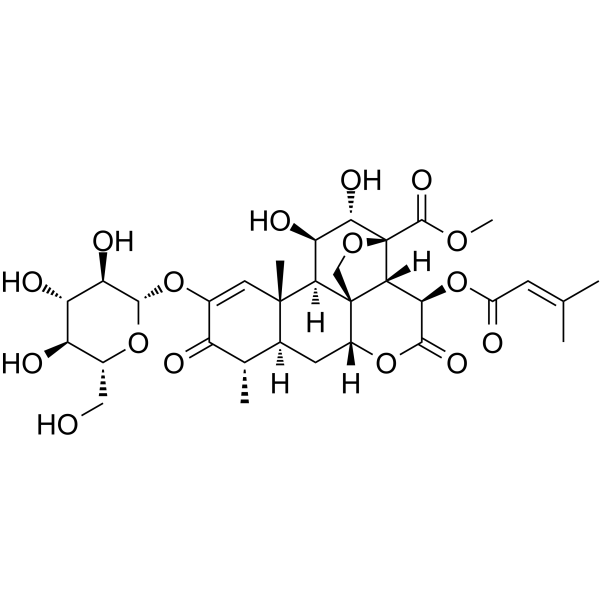
Bruceoside A
CAS No. 63306-30-9
Bruceoside A( —— )
Catalog No. M31791 CAS No. 63306-30-9
Bruceoside A could be transformed into the potent anticancer component brusatol in vivo, rather than its direct deglycosylated metabolite bruceosin.
Purity : >98% (HPLC)
 COA
COA
 Datasheet
Datasheet
 HNMR
HNMR
 HPLC
HPLC
 MSDS
MSDS
 Handing Instructions
Handing Instructions
| Size | Price / USD | Stock | Quantity |
| 5MG | 311 | In Stock |


|
| 50MG | Get Quote | In Stock |


|
| 100MG | Get Quote | In Stock |


|
Biological Information
-
Product NameBruceoside A
-
NoteResearch use only, not for human use.
-
Brief DescriptionBruceoside A could be transformed into the potent anticancer component brusatol in vivo, rather than its direct deglycosylated metabolite bruceosin.
-
DescriptionBruceoside A could be transformed into the potent anticancer component brusatol in vivo, rather than its direct deglycosylated metabolite bruceosin. It significantly inhibited P-388 lymphocytic leukemic cell RNA and protein synthesis in tissue culture.
-
In Vitro——
-
In VivoBruceoside A could be transformed into the potent anticancer component brusatol in vivo, rather than its direct deglycosylated metabolite bruceosin. Animal Model:Male ICR mice weighing 25.0 ± 5.0 g.Dosage:22.5 mg/kg.Administration:Intragastrically administrated.Result:Reached its highest levels in three hours with a half-life value of 3.99 h.
-
Synonyms——
-
PathwayOthers
-
TargetOther Targets
-
Recptor——
-
Research Area——
-
Indication——
Chemical Information
-
CAS Number63306-30-9
-
Formula Weight682.7
-
Molecular FormulaC32H42O16
-
Purity>98% (HPLC)
-
SolubilityIn Vitro:?DMSO : 250 mg/mL (366.21 mM)
-
SMILES——
-
Chemical Name——
Shipping & Storage Information
-
Storage(-20℃)
-
ShippingWith Ice Pack
-
Stability≥ 2 years
Reference
molnova catalog



related products
-
Sulfacetamide
Sulfacetamide is used to treat blepharitis or conjunctivitis (in eye-drop solution) by limiting the presence of folic acid which bacteria need to survive.
-
Garetosmab
Garetosmab (REGN 2477) is A whole-human IgG4 monoclonal antibody that selectively inhibits activin A and acts on COVID-19 44.
-
Dynorphin B (1-13) (...
Dynorphin B (1-13), a 13 amino acid, is an extraordinarily potent opioid peptide.



 Cart
Cart
 sales@molnova.com
sales@molnova.com


